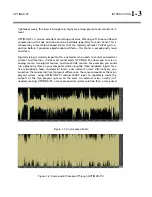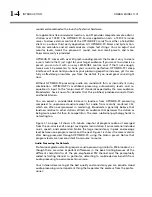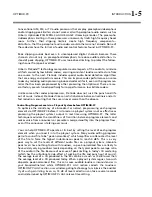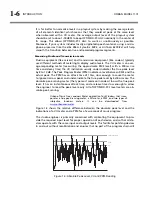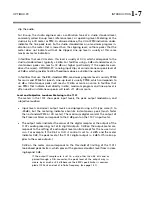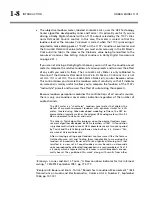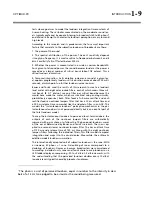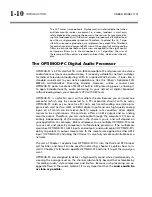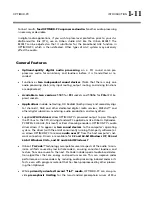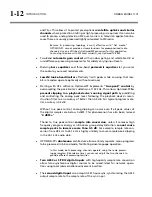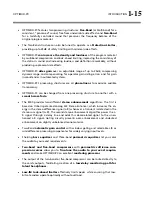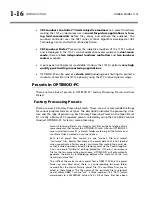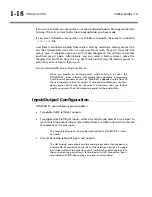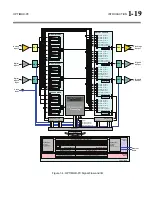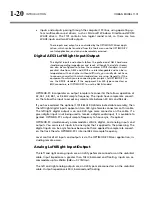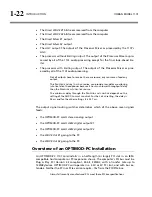
1-8
INTRODUCTION
ORBAN MODEL 1101
•
The subjective loudness meter, labeled
L
OUDNESS
L
EVEL
, uses the CBS Technology
Center algorithm developed by Jones and Torick
. It is primarily useful if you are
driving a Dolby Digital channel with an 1101 output selected by the 1101’s Dial-
norm
R
EFERENCE
S
OURCE
control. In this case, the meter is scaled so that the
loudness level at the consumer’s receiver is correct when the 1101’s processing is
adjusted to make dialog peak at “0 dB” on the 1101’s Loudness Level meter and
the
D
IALNORM
R
EFERENCE
value (which you must enter manually in the I/O Mixer’s
C
ONFIGURATION
tab) is the same as the Dialnorm value being transmitted to the
consumer’s receiver. (See
Setting Output Loudness in Dolby Digital transmissions
on page 2-41.)
If you are not driving a Dolby Digital channel, you can still use the Loudness Level
meter to compare the relative loudness of various presets and to assess the effect
of any edits you make to them. The
L
OUDNESS
L
EVEL
Meter is only calibrated to
D
IALNORM
if the Dialnorm
R
EFERENCE
S
OURCE
in
I/O
M
IXER
>
C
ONFIGURATION
is not
set
O
FF
. If it is set
O
FF
, the
L
OUDNESS
M
ETER
S
ENSITIVITY
control becomes active.
This control allows you to scale the loudness meter’s sensitivity so that it indicates
on-scale and is mainly useful to allow you to compare the loudness of the 1101’s
“radio-style” presets and to assess the effect of customizing those presets.
Because loudness perception combines the contributions of all acoustic sources,
there is only one Loudness Level meter indication regardless of the number of
audio channels.
The CBS meter is a “short-term” Loudness Level meter that displays the
details of moment-to-moment loudness with dynamics similar to a VU
meter. Created using Orban-developed modeling software, the DSP im-
plementation typically matches the original CBS analog meter within 0.5
dB on sinewaves, tone bursts and noise.
The Jones & Torick algorithm improves upon the original loudness meas-
urement algorithm developed by CBS researchers in 1967. Its foundation
is psychoacoustic studies done at CBS Laboratories over a two year period
by Torick and the late Benjamin Bauer, who built on S. S. Stevens’ ‘50s-
era work at Harvard University.
After surveying existing equal-loudness contour curves (like the famous
Fletcher-Munson set) and finding them inapplicable to measuring the
loudness of broadcasts, Bauer and Torick organized listening tests that
resulted in a new set of equal-loudness curves based on octave-wide
noise reproduced by calibrated loudspeakers in a semireverberant 16 x 14
x 8 room, which is representative of a room in which broadcasts are nor-
mally heard. They published this work
along with results from other
1
Bronwyn L. Jones and Emil L. Torick, “A New Loudness Indicator for Use in Broad-
casting,” J. SMPTE September 1981, pp. 772-777.
2
Benjamin B. Bauer and Emil L. Torick, “Researches in Loudness Measurement,” IEEE
Transactions on Audio and Electroacoustics, Volume AU-14, Number 3, September
1966, pp. 141-151
Summary of Contents for Optimod-PC 1101
Page 4: ......
Page 14: ......
Page 121: ...OPTIMOD PC OPERATION 3 1 Section 3 Operation Figure 3 1 The OPTIMOD PC Control Application...
Page 192: ...3 72 OPERATION ORBAN MODEL 1101...
Page 204: ......
Page 210: ......
Page 212: ...5 2 UNINSTALLATION ORBAN MODEL 1101...
Page 236: ......










